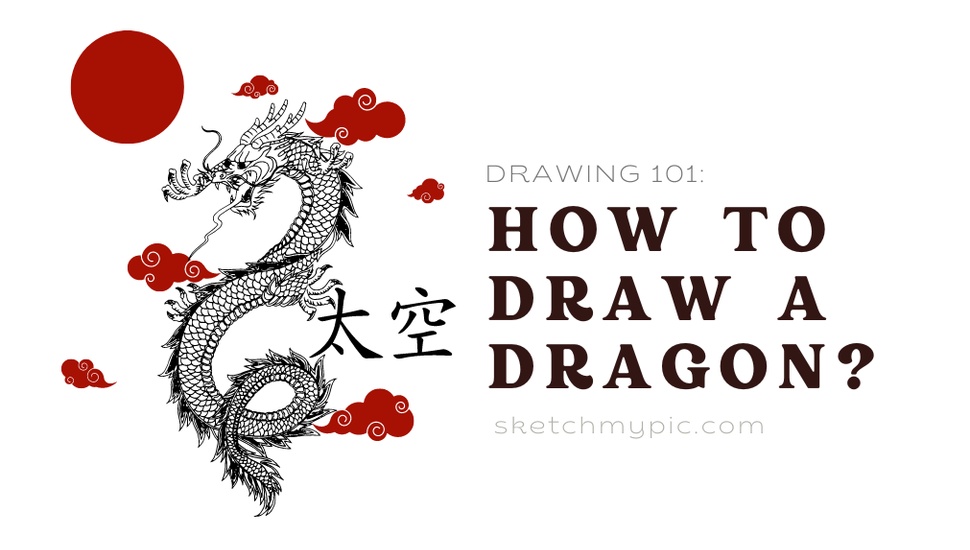
By Jinee
How To'sWhether you are a professional artist or enjoy drawing as a hobby, learning to draw a dragon can be an engaging challenge that helps broaden your artistic horizons. Creating a dragon drawing requires careful attention to detail, patience, and a touch of imagination. From the shape of the head to the scales on the body, the positioning of the wings, and the overall posture, every aspect of a dragon drawing demands precision and careful consideration.
Moreover, dragon drawing can serve as a gateway to storytelling. The intricate details you put into your dragon drawing can inspire you to create a whole fantasy world around the character you have drawn. You can explore different personalities, emotions, and backgrounds for your dragon and develop detailed stories that might include interacting with other creatures, character development, or epic battles.
This article will guide you through creating a detailed and captivating dragon drawing. We will provide you with essential tips on the materials you need, how to begin, what features to pay attention to, and many more. By the end of this guide, you will have all the information you need to create your own fantastic dragon drawings, each bursting with creativity and personal expression. Let's begin!
Before we begin, let's gather the materials needed for this project. You will need the following:
To start, let's begin with the dragon's head. Begin by drawing a circle to serve as the foundation of the head shape. Add two lines on either side for the jaw, creating a wider base for the snout. Next, draw two perpendicular lines across the circle to create the basic shape of the muzzle. This will help you position the eyes, nose, and mouth accurately. Draw the dragon's eyes—almond-shaped—with depth and intensity. Add nostrils to the muzzle, making them curved slits to give a touch of realism. Finally, add details to the eyes, such as pupils and eyelashes, to bring your dragon to life.
Moving on to the body, start by drawing the dragon's neck. Make it thick and muscular to match the powerful appearance of the head. From there, draw the upper body and continue with the lower body, paying attention to the proportions and overall posture you wish to capture. You may choose to make your dragon standing tall, hovering in flight, or crouching with a menacing pose. Next, give your dragon wings by drawing two large, triangular shapes on either side of the body. The wings should be proportional to the body size and positioned to provide balance. As you proceed, add the dragon's limbs, making sure they are proportionate and well-defined. Finish by drawing the claws or talons at the end of each limb, and don't forget to incorporate the dragon's tail.
Once you have the basic shape of the dragon drawn, it's time to add intricate details, which will make your drawing more realistic and captivating. Begin by bringing your dragon to life with scales throughout the body and wings. Start from the head and work your way to the tail, adding carefully crafted scales of various sizes and shapes. Remember to make the scales smaller towards the back of the body to create a sense of depth and perspective. As you progress, incorporate shading and depth to your dragon drawing. Use hatching, cross-hatching, or shading techniques to create contrast and add dimension to the dragon's features. Pay attention to light sources and consider how they would interact with the dragon's form to evoke a sense of realism.
If you want to add color to your dragon drawing, you can use either colored pencils or markers to achieve the desired effect. Consider the color scheme you want for your dragon—whether it's a fierce, fiery red or a mystical, iridescent blue. Use darker shades on the underside of the dragon's body and make the scales on its back lighter to create contrast and enhance the three-dimensional aspect of your drawing. Pay attention to color blending techniques to achieve a smooth transition between different shades. Experiment with different color combinations and techniques to bring out the unique personality of your dragon drawing.
Here are some fun dragon drawing facts to enhance your knowledge and creativity:
These fun dragon drawing facts can enhance your understanding and appreciation for the art form and inspire you to create even more captivating dragon drawings. Let your imagination run wild, and enjoy the process of bringing these mythical creatures to life on paper!
In conclusion, drawing a dragon can be a challenging yet highly rewarding artistic endeavor. By following these step-by-step instructions, you can create a detailed and captivating dragon drawing. Remember to practice regularly, as with any skill, to refine and improve your technique. Embrace your creativity and explore various dragon designs, experimenting with different poses, details, and color schemes. With time, dedication, and a touch of imagination, you will be able to create stunning dragon drawings that showcase your artistic abilities. Have fun and enjoy the journey of bringing these mythical creatures to life on paper!
I hope this detailed guide helps you in creating your amazing dragon drawing. Happy drawing!